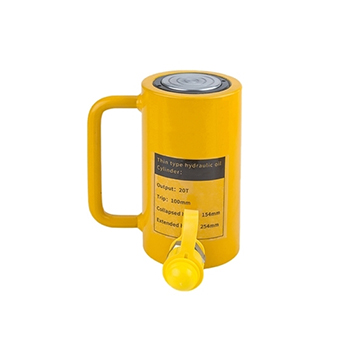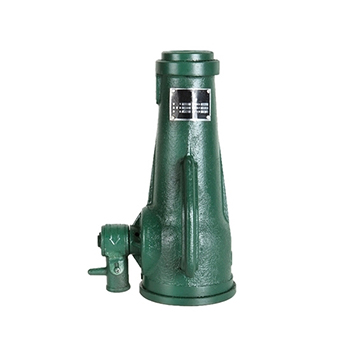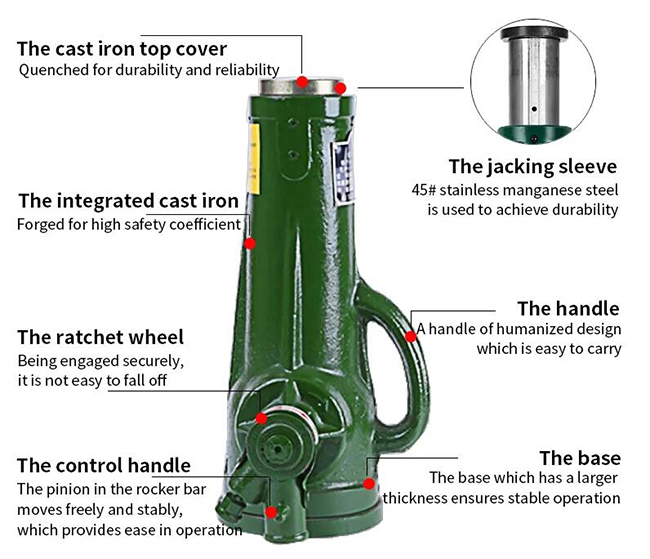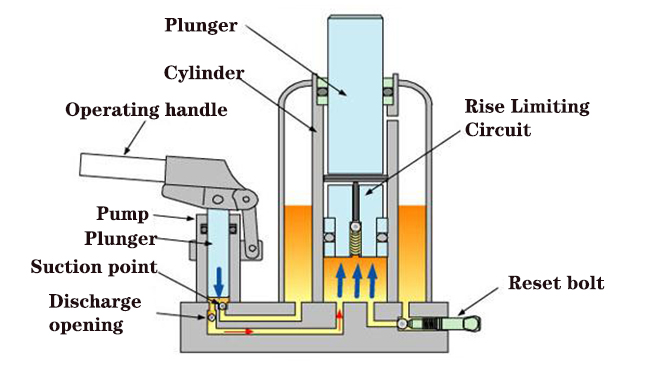Difference between Hydraulic Jack and Screw Jack
There are many types of jacks, and different types of jacks have good performance in their own suitable fields. If you give a total score to the jacks, the most common ones are nothing more than hydraulic jacks and mechanical jacks, and different jacks are often being used for comparison. So today we mainly talk about the difference between hydraulic jacks and mechanical screw jacks.
Different basics
Hydraulic jack: It is a jack that uses a plunger or a hydraulic cylinder as a rigid lifting piece.
The hydraulic jack operates on the working principle of hydraulic control, which contains an internal circulation filled with hydraulic oil, and its hydraulic oil can be controlled by a hydraulic grease pump. When the hydraulic oil is in the oil tank, the oil tank will send the hydraulic oil into the variable cylinder to achieve high pressure, thereby driving the piston to rotate and push the heavy part to rise or fall to the designated position. When the locking function is achieved, the jack will be at its best Effect.
The hydraulic jack drives a hydraulic pump by manpower or electricity. It is transmitted through a hydraulic system and uses a cylinder or a piston as a lifting piece. Hydraulic jacks can be divided into integral and separate. The integral hydraulic pump is integrated with the hydraulic cylinder, and the separate hydraulic pump is separated from the hydraulic cylinder, and connected with a high-pressure hose in the middle. The hydraulic jack has a compact structure and can lift heavy objects smoothly. The lifting capacity has reached 750 tons, and the transmission efficiency is high, so it is widely used. However, hydraulic jacks are prone to oil leakage and are not suitable for supporting heavy objects for a long time.
The biggest advantage of the hydraulic jack is that it has extremely high accuracy, which can improve work efficiency. The hydraulic jack can control torque, which can realize high-precision operation. Even in the case of very small pressure, the hydraulic jack can still maintain good stability and accuracy, so that it can realize fast locking of materials. In addition, the hydraulic jack has relatively small noise and is easy to operate.
Screw jack: Also known as mechanical jack, it relies on manpower to drive through a screw, and the screw or nut sleeve is used as the jacking piece. The screw jack uses the swing of the rocker to rotate the pinion, and it drives the screw to rotate and pushes the lifting sleeve through a pair of bevel gears so that the weight rises or falls.
The screw jack is composed of several parts such as a base with a nut, a lifting screw, a top for supporting a heavy object, and a handle for rotating the lifting screw. The nut is fixed on the upper end of the base with screws. When the handle is turned, the screw moves up and down in the nut to lift or lower the weight. Since the friction angle between the threaded screw and the nut has a self-locking effect, it will not fall under the action of heavy objects.
The handle is not allowed to rotate greatly in the workplace, and a screw jack with a ratchet wrench can be used. When working, only need to shake the handle back and forth in a small range to lift the screw. The top supports the heavy object directly. It does not rotate with the rotation of the screw, the bottom is used as a support for the screw, and its height can accommodate the length of the entire lifting screw. In addition, a horizontal screw bracket is installed under the base of the screw jack, which can not only lift or lower heavy objects but also move horizontally. This operation is often used in equipment installation.
Screw jacks can be used laterally, which cannot be achieved with hydraulic jacks. The screw jack has a large lifting capacity and is an ideal large-tonnage mechanical jack. It is widely used in building support, bridge construction, equipment handling, and other occasions, bringing many conveniences to people's production and life.
Hydraulic jack features
A hydraulic jack refers to a jack that uses a plunger or a hydraulic cylinder as a rigid jack. Hydraulic jack features:
- Equipped with various accessories, it has multiple functions such as lifting, jacking, and shoveling.
- High safety factor, the oil pump can automatically unload when overloaded.
- The oil pump adopts a composite structure, and the flow rate is large when it is no-load.
- The speed is fast, the flow rate is small when the load is heavy, and the speed is slow.
Screw Jack Features
- Lightweight, easy to carry.
- Easy maintenance, safe and reliable use.
- The structure is simple, but the transmission efficiency is low and the return journey is slow.
- Large tonnage mechanical jack.
Working principle
Screw jack:
When the auger is manually rotated, the auger moves up, which pushes the piston up. As the piston rises, the fluid in the cylinder is pressurized, and the fluid flows outward, pushing the lever above the cylinder upward. The rise of the lever lifts the weight on the base upward. The principle of mechanical jack (screw jack) can be expressed by the following formula:
F1/F2 = L2/L1
Among them, F1 and F2 represent the input force and output force, respectively, and L1 and L2 represent the lever arm lengths of the input force and output force, respectively. According to this formula, we can see that the output force of a mechanical jack can be many times greater than the input force because the lever arm of the output force is much longer than the lever arm of the input force.
Hydraulic jacks:
In principle, the hydraulic jack is based on the principle of Pascal's principle, that is to say, the pressure of the liquid is consistent everywhere. In a balanced system, the pressure exerted on the smaller piston is relatively small, while the pressure exerted on the larger piston is relatively small. The pressure is also relatively high, which keeps the liquid still. Therefore, through the transmission of liquid, different pressures on different ends can be obtained, so that a transformation can be achieved. Whiskey jack is exactly to have utilized this principle to reach the transmission of power. The following is the basic equation for static pressure:
p=p0+ρgh
For the liquid in a closed container, when the applied pressure p0 changes, as long as the liquid remains in its original static state, the pressure at any point in the liquid will change by the same magnitude. This is the principle of static pressure transfer or called Pascal's principle. Applying a certain pressure to one piston in a hydraulic system must produce the same pressure increase on the other piston. If the second piston has 10 times the area of the first piston, the force acting on the second piston will be 10 times greater than the first piston, while the pressure on both pistons will still be equal.

